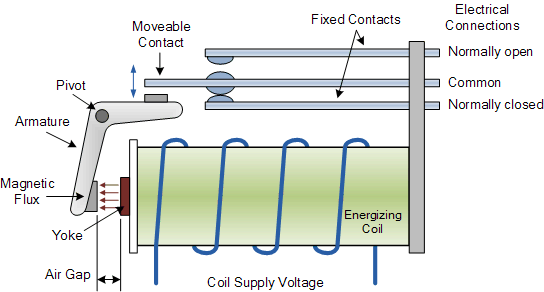Difference between revisions of "Relays"
| Line 8: | Line 8: | ||
| − | There are various of kinds of relays, but they | + | There are various of kinds of relays, but in some way, they all share the same kind of components: |
- an electromagnet (that is the coil with the core metal), | - an electromagnet (that is the coil with the core metal), | ||
- some mechanical hardware to convey magnetic forces and | - some mechanical hardware to convey magnetic forces and | ||
- a number of contacts. | - a number of contacts. | ||
| + | |||
| + | The relay is operated by letting a current flow through the wire of the electromagnet. This causes magnetic forces to develop and these will become strong enough to alter the position of the movable contact, thus allowing one contact to be broken and another to be made. | ||
| + | |||
| + | Of course, the opposite happens, when the current stops flowing through the electromagnet. | ||
| + | |||
| + | Especially switching off the current flow, brings some special electronic challenges, as the energy stored in the electromagnet during current flow, causes a strong negative voltage across the coil. | ||
| + | |||
| + | Any change in the current through an inductor creates a changing flux, inducing a voltage across the inductor. By Faraday's law of induction, the voltage induced by any change in magnetic flux through the circuit is[4] | ||
| + | |||
| + | v = {d\phi \over dt} \, | ||
| + | |||
| + | From (1) above[4] | ||
| + | |||
| + | [[File:Any change in the current through an inductor creates a changing flux, inducing a voltage across the inductor. By Faraday's law of induction, the voltage induced by any change in magnetic flux through the circuit is[4] | ||
| + | |||
| + | v = {d\phi \over dt} \, | ||
| + | |||
| + | From (1) above[4] | ||
| + | |||
| + | v = {d \over dt}(Li) = L{di \over dt} \, (2) ]] | ||
Revision as of 15:18, 1 March 2016
The relay is z device used to switch larger currents or to create isolation. However basically a simple device, it requires some measures to utilize it properly.
There are various of kinds of relays, but in some way, they all share the same kind of components:
- an electromagnet (that is the coil with the core metal), - some mechanical hardware to convey magnetic forces and - a number of contacts.
The relay is operated by letting a current flow through the wire of the electromagnet. This causes magnetic forces to develop and these will become strong enough to alter the position of the movable contact, thus allowing one contact to be broken and another to be made.
Of course, the opposite happens, when the current stops flowing through the electromagnet.
Especially switching off the current flow, brings some special electronic challenges, as the energy stored in the electromagnet during current flow, causes a strong negative voltage across the coil.
Any change in the current through an inductor creates a changing flux, inducing a voltage across the inductor. By Faraday's law of induction, the voltage induced by any change in magnetic flux through the circuit is[4]
v = {d\phi \over dt} \,
From (1) above[4]
[[File:Any change in the current through an inductor creates a changing flux, inducing a voltage across the inductor. By Faraday's law of induction, the voltage induced by any change in magnetic flux through the circuit is[4]
v = {d\phi \over dt} \,
From (1) above[4]
v = {d \over dt}(Li) = L{di \over dt} \, (2) ]]

